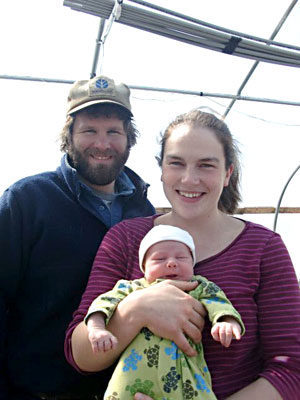 |
| Mike and Christa Bahner with their now 2-year-old daughter Lizzy. Photos courtesy of Bahner Farm. |
By Holli Cederholm
Bahner Farm’s 37 acres of woodlot and tillable land abuts a busy stretch of Rt. 3 in Belmont, Maine, with just enough road frontage for their farmhouse, barn and, most importantly, their newly built farmstand. When Mike and Christa Bahner purchased the land in 2009, location and road exposure were determining factors.
The Bahners had learned the ins and outs of diversified organic vegetable farming in central Maine. Mike was a MOFGA apprentice at Peacemeal Farm in Dixmont for three years and then managed the crew there in his fourth year. Christa apprenticed at a few Maine farms, including Peacemeal (where she and Mike met), before and after completing a degree in plant and soil sciences at UMass Amherst. She then formed Double Bit Farm in a two-year partnership with Molly Crouse (now owner of Nettie Fox Farm in Newburgh) while they were MOFGA’s farmers-in-residence.
Through these experiences the Bahners gained the confidence to start their own farm business and the expertise to steadily increase their production over time. In 2012 they cultivated 4-1/2 acres of certified-organic mixed vegetables, mostly on leased land, with “a lot of succession plantings,” including extended-season plantings in their three high tunnels. In the coming season, they will increase their cultivated area by another acre or so on nearby leased ground.
Their knowledge of the local produce scene also influenced their marketing strategy, which currently includes three weekly farmers’ markets – in Camden, Northeast Harbor and Bar Harbor – as well as more localized sales through their farmstand and CSA (Community Supported Agriculture) program. Mike says, “This three-pronged marketing system was a way for us to get this business up and going.”
Growing Customers
In 2009, while busy preparing for the farm’s inaugural 2010 growing season, the Bahners were considering how to diversify their markets and their crop plan. Waldo County alone had some 20 vegetable CSAs, says Mike. This didn’t deter the Bahners from forming their own CSA, but did force them to approach it differently.
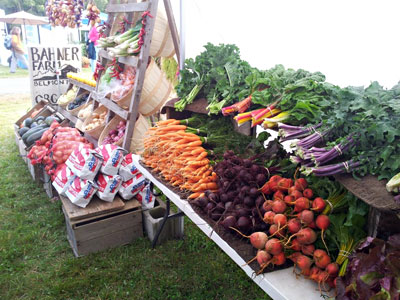 |
| Bahner Farm produces organic mixed vegetables for farmers’ markets, a CSA, and their farmstand. |
“The last thing I want to do is compete with other farmers … I want everyone to succeed,” says Mike.
Instead of targeting solely existing markets for their vegetables, such as the farmers’ markets where they sell, the Bahners wanted to find customers who weren’t eating local produce or who weren’t eating very much produce at all.
“We decided to focus our marketing on what I call ‘customer creation,’” says Mike.
They’ve employed different tactics to grow their customer base, from partnering with area workplaces such as Waldo County General Hospital and Athena Health for CSA deliveries, to developing an active web presence. Christa manages the farm’s website, Facebook page, and recipe blog; the latter functions as a digital newsletter for their CSA shareholders. The two also invest a small amount monthly into Google AdWords to increase the visibility of their farm website on related Google searches.
Their efforts have paid off. While farmers’ markets continue to be their “bread and butter,” their CSA grows annually. In 2012, 45 shareholders participated in their summer CSA and 25 in their winter CSA. In the coming season, they anticipate that more families will sign up, and they are partnering with local cheese maker Caitlin Hunter of Appleton Creamery to offer additional enticement: a cheese add-on share.
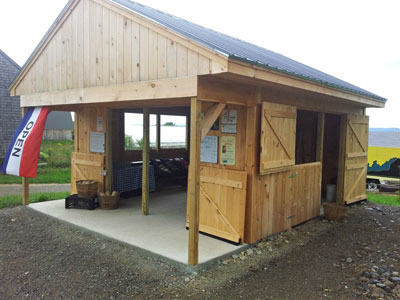 |
| The Bahners’ farmstand has two sets of open-hinge stable-style doors that can double as windows. |
The Farmstand
“Our long-term goal is to move more and more of that market on-farm,” says Mike.
Maine’s Rt. 3 is well traveled by commuters from Augusta to Belfast, with the state’s Department of Transportation estimating traffic volume at 3,000 to 7,000 people daily; seasonal tourism drives up the average. Higher summer traffic bodes well for the Bahners, who saw these numbers as an opportunity to create yet another market and bring customers directly to their farm.
In March 2012, the Bahners launched a crowd-funding campaign through Kickstarter, an online platform where individuals can seek funding for their creative projects from the masses, to finance earthworks and construction of a farmstand.
“It’s an all or nothing deal,” says Mike. Before launching a campaign, a funding goal is established, and it must be met before the project’s deadline lapses.
Donations to individual campaigns are often viewed as investments in a business or project. “It’s people who just really want to support the farm,” says Christa.
Mike speculates that the list of donors includes family and friends, CSA members and farmers’ market customers, as well as people they’ve never met who believe in their project.
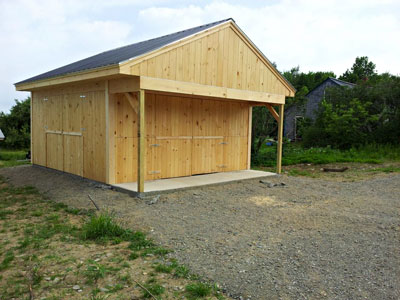 |
| Farmstand construction was completed in spring of 2012 following a successful Kickstarter crowd-funding campaign. |
Typical to crowd-funding conduct, the Bahners rewarded pledges with farm goods: Bahner Farm bumper stickers, tote bags, CSA shares and more. Their campaign met its funding goal of roughly $12,500 in mid-April, allowing the Bahners to move forward.
“It was really exciting…,” says Christa; “an important reminder about the importance of social media.”
Construction was completed in spring 2012. The earthworks consisted of laying 18 inches of gravel and pouring concrete for a floating slab, as well as smoothing the barnyard to create a pull-through style driveway and a parking area that accommodates up to eight cars. The stand design is simple: a 16- by 20-foot single-room building with two sets of open-hinge stable-style doors that can double as windows.
“It’s small enough that when we didn’t have a lot of stuff, it wouldn’t look empty,” says Mike. An overhang off the front allows them to “open up and spill out” with more bountiful harvests.
The stand was open for business five days a week in 2012, and doubled as a site for on-farm pick-up of CSA shares. The stand will be open seven days in the future.
Increasing On-Farm Sales
The Bahners hope their farmstand will become a regular destination for commuters traveling Rt. 3, along with members of their local community. One of their best marketing strategies to date may also be the most straightforward.
“A sign is another piece of physical marketing,” says Mike, who built the farm’s letterboard sign for under a $100. “We’re talking plywood, letterboard track and letters.”
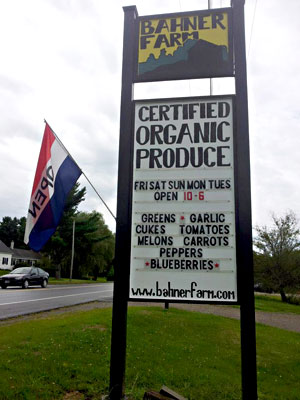 |
| Bahner Farm’s homemade letterboard sign advertises the daily farmstand products to steady traffic on Route 3. |
Any passerby can easily read a small selection of what’s available at the farmstand on any given day.
In the works for 2013 are interior infrastructure: built-in shelving, a check-out counter, and a simple glass-door refrigerator to keep more perishable produce, such as baby salad greens, from wilting in the summer heat.
Refrigeration would also allow them to stock products such as meat and cheese from other local producers. “I really like the idea of offering a more complete spectrum of foods for people,” says Christa.
The Bahners are increasing variety in their own production by cultivating small fruits. Their crop plan has always included melons, but they also manage 14 acres of certified-organic lowbush blueberries in Belmont. The acreage is split into two 7-acre fields, each harvested every other year.
“We’re starting to branch into strawberries, raspberries, blackberries,” says Mike. Their 1/4-acre trial plantings, also certified-organic, will start bearing this season. A “niche orchard” of pears and plums is part of their motivation for clearing additional open land on their property.
“With the farmstand, the fruit is something that gets people to pull over,” says Mike. He says that sweet corn is another traffic-stopper, but the profit margin is notoriously low, or nonexistent. “Fruits are profitable … they are a profit-leader so to speak.”
Bahner Farm is prepared to follow customers’ preferences on what to stock at the stand. They hope to increase sales of seedlings and cut flowers. Bahner Farm already provides surplus seedlings of sought-after crops and potted herbs to their farmers’ market clientele. The stand could grow a market for additional varieties of seedlings, such as lettuce and Swiss chard.
“I think we’re going to see an increase in demand for all of our products,” says Mike.
They attribute the successful growth of their fledgling farm to their careful planning. “The things we’re doing really well at are marketing, business planning, increasing production,” says Christa.
That, and they also really love what they’re doing and are totally committed to organic agriculture. “I like providing pretty much people’s basic needs … They need to eat good food,” says Christa.
Their other farm goals are to raise soil fertility and promote long-term soil health; improve record keeping; and balance how to be good farm managers as well as mentors to their three or four farm apprentices annually, all while raising their 2-year-old daughter, Lizzy.
About the author: Holli Cederholm was a MOFGA farmer-in-residence, with Brian St. Laurent. Their Proud Peasant Farm is now located in Washington, Maine.
